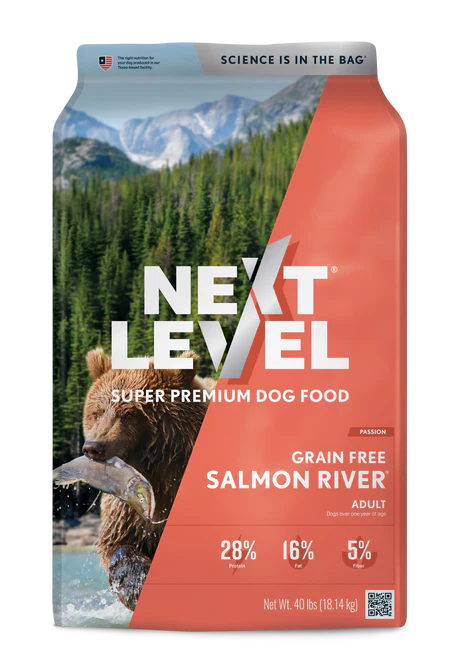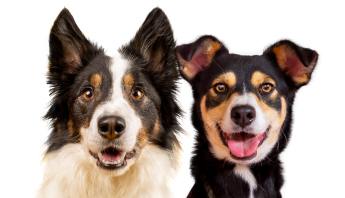Next Level Passion Dry Dog Food Review

DogFoodAdvisor is reader supported See how
All reviews are 100% impartial but if you buy using links on this page, we may earn a referral fee.
Our Verdict
Next Level Passion dry dog food receives the Dog Food Advisor high rating, 4-stars.
Pros
- Contains omega-3
- Good levels of protein
Cons
- Lack of transparency
- Contains controversial ingredients
The product line includes five dog foods.
Each recipe includes its AAFCO nutrient profile: Growth (puppy), Maintenance (adult), All Life Stages, Supplemental or Unspecified.
| Product line | Rating | AAFCO |
|---|---|---|
| Next Level Hi-Pro 30 LS | 4 | A |
| Next Level Hi-Pro Professional | 4 | A |
| Next Level Hi-Energy | 3.5 | M |
| Next Level Normally Active | 3 | M |
| Next Level Grain Free Salmon River | 4 | M |
Recipe and Label Analysis
Next Level Grain Free Salmon River was selected to represent the other products in the line for a detailed recipe and nutrient analysis.
Next Level Grain Free Salmon River
Estimated Dry Matter Nutrient Content
Protein
Fat
CarbsCarbohydrates
Menhaden fish meal, peas, canola oil (preserved with mixed tocopherols), sweet potato, pea protein, dried beet pulp, dried salmon, yeast culture, blood meal, dehydrated alfalfa meal, natural flavors, flaxseed, potassium chloride, dried kelp, salt, choline chloride, taurine, l-carnitine, dl-methionine, mixed tocopherols (preservative), dried chicory root, yucca schidigera extract, vitamins (vitamin A supplement, vitamin D3 supplement, vitamin E supplement, niacin, folic acid, biotin, calcium pantothenate, thiamine mononitrate, pyridoxine hydrochloride, riboflavin supplement, l-ascorbyl-2-polyphosphate (source of vitamin C), vitamin B12 supplement), minerals (zinc sulfate, ferrous sulfate, manganese sulfate, copper sulfate, zinc proteinate, manganese proteinate, copper proteinate, calcium iodate, selenium yeast), dried enterococcus faecium fermentation product, dried lactobacillus acidophilus fermentation product, dried aspergillus niger fermentation extract, dried trichoderma longibrachiatum fermentation extract, dried bacillus subtilis fermentation extract
Fiber (estimated dry matter content) = 5%
Red denotes any controversial items
| Estimated Nutrient Content | |||
|---|---|---|---|
| Method | Protein | Fat | Carbs |
| Guaranteed Analysis | 28% | 16% | NA |
| Dry Matter Basis | 31% | 18% | 43% |
| Calorie Weighted Basis | 27% | 37% | 37% |
Ingredients Analysis
The first ingredient in this dog food is menhaden fish meal. Because it is considered a meat concentrate, fish meal contains almost 300% more protein than fresh fish itself.
Menhaden are small ocean fish related to herring. They’re rich in protein and omega-3 fatty acids. What’s more, in their mid-depth habitat, menhaden are not exposed to mercury contamination as can be typical with deep water species.
Fish meal is typically obtained from the “clean, dried, ground tissue of undecomposed whole fish and fish cuttings” of commercial fish operations.1
The second ingredient includes peas. Peas are a quality source of carbohydrates. And like all legumes, they’re rich in natural fiber.
However, peas contain about 25% protein, a factor that must be considered when judging the meat content of this dog food.
The third ingredient is canola oil. Unfortunately, canola can be a controversial item. That’s because it can sometimes (but not always) be derived from genetically modified rapeseed.
Yet others cite the fact that canola oil can be a significant source of omega-3 fatty acids.
In any case, plant-based oils like canola are less biologically available to a dog than fish oil as a source of quality omega-3 fats.
The fourth ingredient is sweet potato. Sweet potatoes are a gluten-free source of complex carbohydrates in a dog food. They are naturally rich in dietary fiber and beta carotene.
The fifth ingredient is pea protein, what remains of a pea after removing the starchy part of the vegetable.
Even though it contains over 80% protein, this ingredient would be expected to have a lower biological value than meat.
And less costly plant-based products like this can notably boost the total protein reported on the label — a factor that must be considered when judging the meat content of this dog food.
The sixth ingredient is beet pulp. Beet pulp is a controversial ingredient, a high fiber by-product of sugar beet processing.
Some denounce beet pulp as an inexpensive filler while others cite its outstanding intestinal health and blood sugar benefits.
We only call your attention here to the controversy and believe the inclusion of beet pulp in reasonable amounts in most dog foods is entirely acceptable.
The seventh ingredient is dried salmon, a concentrated source of quality marine protein that’s rich in omega-3 fatty acids.
Like other fish meals, salmon powder is typically derived from the “clean, dried, ground tissue of undecomposed whole fish and fish cuttings” of commercial fish operations.1
The eighth ingredient is yeast culture. Although yeast culture is high in B vitamins and protein, it can also be used as a probiotic to aid in digestion.
The ninth ingredient is blood meal. Blood meal is a by-product of slaughter and used to make high-protein (very low ash) animal feeds.
Yet even though some consider it a controversial ingredient, blood meal can still be considered a quality source of animal protein.
From here the list goes on to include a number of other items. But to be realistic, ingredients located this far down the list (other than nutritional supplements) are not likely to affect the overall rating of the product.
This recipe has four notable exceptions.
Firstly, chelated minerals, minerals that have been chemically attached to protein. This makes them easier to absorb. Chelated minerals are usually found in better dog foods.
In addition, we note the inclusion of dried fermentation products in this recipe. Fermentation products are typically added as probiotics to aid with digestion.
Taurine, an important amino acid associated with the healthy function of heart muscle. Although taurine is not typically considered essential in canines, some dogs have been shown to be deficient in this critical nutrient.
Since taurine deficiency appears to be more common in pets consuming grain-free diets, we view its presence in this recipe as a positive addition.
Next is chicory root. Chicory is rich in , a starch-like compound made up of repeating units of carbohydrates and found in certain roots and tubers.
Not only is inulin a natural source of soluble dietary fiber, it’s also used to promote the growth of healthy bacteria in a dog’s digestive tract.
Nutrient Analysis
Based on its ingredients alone, Next Level Grain Free Salmon River looks like an above-average dry product.
The dashboard displays a dry matter protein reading of 31.1%, a fat level of 17.8% and an estimated carbohydrate level of 43.1%.
As a group, the brand features a protein content of 28.4% and a mean fat level of 18.5%. Together these figures suggest a carbohydrate content of 45.1% for the overall product line, alongside a fat to protein ratio of 65%.
This means the Next Level Passion product range contains above-average protein, below-average carbohydrate, above-average fat, when compared to typical dry dog food.
Next Level Dog Food Recall History
The following automated list (if present) includes all dog food recalls related to Next Level through March 2025.
No recalls noted.
You can view a complete list of all dog food recalls since 2009 here.
Our Rating of Next Level Dog Food
This product range contains good-quality ingredients for all life stages and activity levels. With grain-inclusive and grain-free options and uses a significant amount of named meat meals as its dominant source of animal protein.
Compare Next Level Dog Food
How does Next Level compare with The Dog Food Advisor's most recommended brands?
A Final Word
The Dog Food Advisor does not accept money, gifts, samples or other incentives in exchange for special consideration in preparing our reviews.
However, we do receive a referral fee from online retailers (like Chewy or Amazon) and from sellers of perishable pet food when readers click over to their websites from ours. This helps cover the cost of operation of our free blog. Thanks for your support.
For more information, please visit our Disclaimer and Disclosure page.






